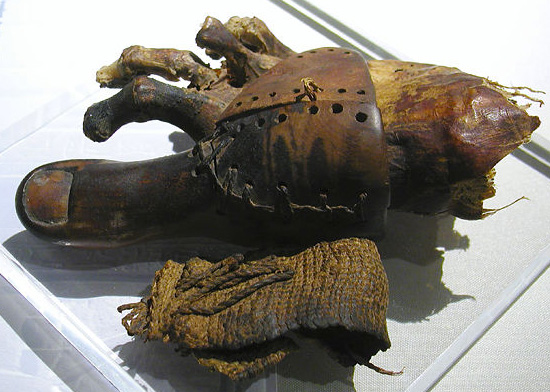
An early mention of an ancient prosthetic comes from the Greek historian Herodotus, who tells the story of Hegesistratus, an Ancient Greek diviner who cut off his own foot to escape his Spartan captors—and replaced it with a wooden one.
We are living through an incredibly exciting period for prosthetics. A pioneering brain computer interface that will allow veterans to control artificial body parts with their minds was recently announced by researchers in Virginia in the US. Meanwhile, Newcastle University in the UK is developing limbs which “see” objects in front of them and react at speeds comparable with the real thing.
Projects like these are steadily helping people with prostheses to move more naturally and easily than ever before. But what few people appreciate is just how far back this field actually goes.
If you were thinking a couple of hundred years, or maybe since the medieval era, you wouldn’t even be close. Amputations and prostheses date back to ancient times, and saw advances that were heralded as no less life-changing than they are today. It’s a fascinating story of gods, gladiators, and the limits of human endurance that adds a whole other dimension to understanding this discipline.
Use of Ancient Prosthetics Began as a Result of Warfare
Warfare was not kind to the bodies of soldiers in ancient Greece and Rome. It has been estimated that in ancient Greece, about 80 percent of seriously wounded soldiers died on the day of battle. Of the remaining 20 percent, a third died of their injuries after returning home. It is not easy to make direct comparisons with modern times, but these figures are certainly likely to be much higher.
Whether survivors in the ancient era were injured in battle by a blade, spear or missile, or in camp by frostbite or trench foot, their arms, legs, and extremities were incredibly vulnerable. In ancient Greece, they benefited from simple surgical amputations as far back as the late fifth or early fourth century BC. The Hippocratic treatise “On Joints” attests to rudimentary amputations of fingers, toes, hands, and feet but cautions against amputating an entire arm or leg.
Around the same time, orthopaedic surgery had refined to the point that prostheses were starting to become available as alternatives to staffs, sticks, and crutches. We see this in the account of the Greco-Persian War (499-449 BC) by the historian Herodotus, for instance. Herodotus recounts how the Persian diviner, Hegesistratus, when imprisoned by the Spartans, amputated part of his own foot to escape his shackles, then procured a wooden replacement.
Egypt was using similar technology around the same period. Prosthetic toes made from wood or layers of fiber known as cartonnage have been recovered from burial sites, such as the one from a mummy near Luxor, pictured below. They show signs of wear and tear, indicating that they were functional rather than purely cosmetic.

Surgical techniques advanced considerably during the Hellenistic period (323-31 BC), the last era before Greek dominance gave way to Rome. These advances were thanks to medical practitioners at the Museion and Library in Alexandria making in-depth anatomy studies by dissecting and even vivisecting criminals sentenced to death.
This improved their understanding of the circulatory system and led them to discover that blood vessels could be tied off to prevent bleeding, which meant that amputations could be done slowly and carefully. There was less risk that the patient would die of blood loss, and stumps were now more amenable to prosthesis use.
It is unlikely to be a coincidence that prostheses advanced at the same time. An artificial leg recovered from a tomb in Capua in southern Italy, dated to the late fourth or early third century BC, had a wooden core covered in bronze sheeting. This was held in place by a leather and bronze belt, which would have made movement easier.
Another example is the Roman general Marcus Sergius Silus. He lost his right hand during the Second Punic War (218-201BC), which was fought between the Romans and Hannibal of Carthage in latter day Tunisia. But rather than retire, Silus procured an iron hand which he subsequently used to bear his shield, transferring his sword to his left hand instead.

Prosthetics Then and Now
Surviving examples like these indicate that extremity prostheses were designed, commissioned, and manufactured to an individual’s specific preferences. The same artisans that produced personalized armor and weapons likely produced personalized prostheses for wounded veterans.
Considering the ancient association of disabled people with crafts such as metalwork— epitomised by the Greek god Hephaistos and his Roman counterpart Vulcan—artisans may even have drawn on their own experiences of impairment to inspire their creations. Soldiers like Silus would duly have been able to defy their societies’ expectations and continue to play significant roles at moments of historical significance.
We historians do have to speculate here to some extent: we don’t know how soldiers acquired their prostheses since medical treatises do not mention these procedures. Yet, it seems probable that the technology improved due to the horrors of war—just as today’s advances are partly a response to the unprecedented levels of multiple traumatic injuries that soldiers suffered in Afghanistan and Iraq. And then as now, prostheses were collaborative efforts between medics, technologists, and artists.
After the ancient Greek era, prostheses barely improved until the 16th century. That was when Ambroise Paré, the royal surgeon to four successive French kings, invented mechanical versions, including knees and fingers, capable of bending somewhat like the real thing.
So when we see the latest prostheses giving veterans an incomparable quality of life or helping athletes to achieve amazing things at the Paralympics, it is worth reflecting on the distance traveled. We have been trying to make amends for humanity’s worst tendencies for 25 centuries. Long may such advances continue to be a vital consolation.
See all the latest news from Greece and the world at Greekreporter.com. Contact our newsroom to report an update or send your story, photos and videos. Follow GR on Google News and subscribe here to our daily email!



